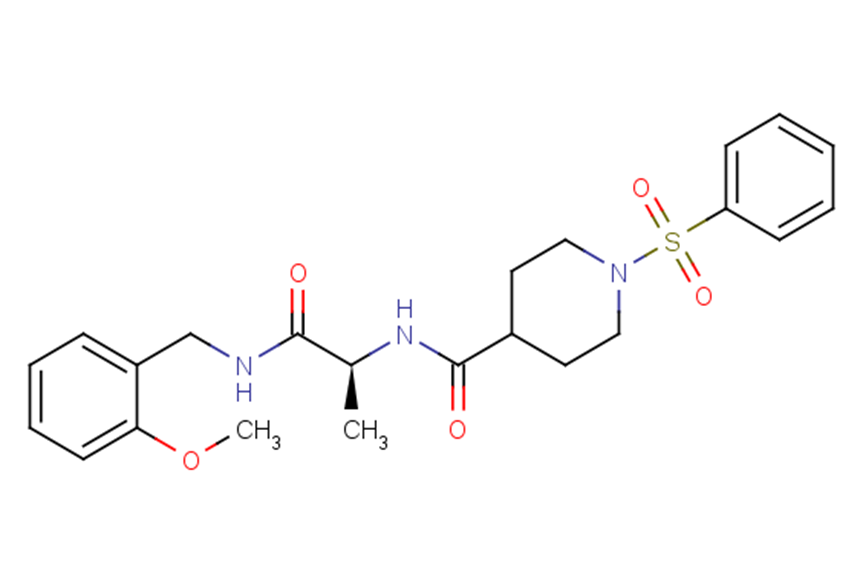
BC-1382
CAS No. 1013753-99-5
BC-1382( —— )
Catalog No. M22211 CAS No. 1013753-99-5
BC-1382 is a potent ubiquitin E3 ligase HECTD2 inhibitor that specificly disrupts the HECTD2/PIAS1 interaction(IC50 of 5 nM).BC-1382, that targeted HECTD2 and attenuated lipopolysaccharide (LPS)- and Pseudomonas aeruginosa-induced lung inflammation.
Purity : >98% (HPLC)
 COA
COA
 Datasheet
Datasheet
 HNMR
HNMR
 HPLC
HPLC
 MSDS
MSDS
 Handing Instructions
Handing Instructions
| Size | Price / USD | Stock | Quantity |
| 5MG | 201 | In Stock |


|
| 10MG | 299 | In Stock |


|
| 25MG | 507 | In Stock |


|
| 50MG | 731 | In Stock |


|
| 100MG | 1017 | In Stock |


|
| 500MG | 2034 | In Stock |


|
| 1G | Get Quote | In Stock |


|
Biological Information
-
Product NameBC-1382
-
NoteResearch use only, not for human use.
-
Brief DescriptionBC-1382 is a potent ubiquitin E3 ligase HECTD2 inhibitor that specificly disrupts the HECTD2/PIAS1 interaction(IC50 of 5 nM).BC-1382, that targeted HECTD2 and attenuated lipopolysaccharide (LPS)- and Pseudomonas aeruginosa-induced lung inflammation.
-
DescriptionBC-1382 is a potent ubiquitin E3 ligase HECTD2 inhibitor that specificly disrupts the HECTD2/PIAS1 interaction(IC50 of 5 nM).BC-1382, that targeted HECTD2 and attenuated lipopolysaccharide (LPS)- and Pseudomonas aeruginosa-induced lung inflammation.
-
In VitroBC-1382 targets HECTD2 and attenuates lipopolysaccharide (LPS)– and Pseudomonas aeruginosa-induced lung inflammation. HECTD2 is an ubiquitin E3 ligase. BC-1382 reduces the severity of cytokine-driven lung inflammation.BC-1382 drastically increases PIAS1 protein level in a nonstimulus condition with IC50≈100 nM.BC-1382 improves PIAS1 protein stability by increasing its t1/2.BC-1382 suppresses LPS-induced PIAS1 degradation and restores PIAS1 protein levels at 800 nM.BC-1382 suppresses LPS-induced proinflammatory cytokines released by human peripheral blood mononuclear cells (PBMCs).
-
In VivoBC-1382 (10 mg/kg; intraperitoneal injection) significantly decreases lavage protein concentrations, lavage cell counts, and cell infiltrates in both PA103-stimulated and LPS-stimulated mice. BC-1382 significantly decreases lavage cytokine levels in both models. Animal Model:C57BL/6J mice were challenged intratracheally with PA103 (104 CFU per mouse) or LPS (3 mg/kg)Dosage:10 mg/kg Administration:Given through intraperitoneal injection Result:Significantly decreased lavage protein concentrations, lavage cell counts, and cell infiltrates in both PA103-stimulated and LPS-stimulated mice.
-
Synonyms——
-
PathwayOthers
-
TargetOther Targets
-
Recptorubiquitin E3 ligase HECTD2
-
Research Area——
-
Indication——
Chemical Information
-
CAS Number1013753-99-5
-
Formula Weight459.56
-
Molecular FormulaC23H29N3O5S
-
Purity>98% (HPLC)
-
SolubilityIn Vitro:?DMSO : 125 mg/mL (272.00 mM)
-
SMILESCOc1ccccc1CNC(=O)[C@H](C)NC(=O)C1CCN(CC1)S(=O)(=O)c1ccccc1
-
Chemical Name——
Shipping & Storage Information
-
Storage(-20℃)
-
ShippingWith Ice Pack
-
Stability≥ 2 years
Reference
1.Coon T A , Mckelvey A C , Lear T , et al. The proinflammatory role of HECTD2 in innate immunity and experimental lung injury[J]. ence Translational Medicine, 2015, 7(295):295ra109.
molnova catalog



related products
-
AMAS
AMAS is a nonclaevable heterobifunctional crosslinker with NHS ester and maleimide groups that allows covalent conjugation of amine- and sulfhydryl-containing molecules.
-
[Lys3, Phe10, Tyr13]...
[Lys3, Phe10, Tyr13] - Autocamtide - 2 - Related Inhibitory Peptide (AIP) Analog
-
Polymyxin B sulfate
Polymyxin B sulphate is a mixture of polymyxins B1 and B2, obtained from Bacillus polymyxa strains.



 Cart
Cart
 sales@molnova.com
sales@molnova.com


